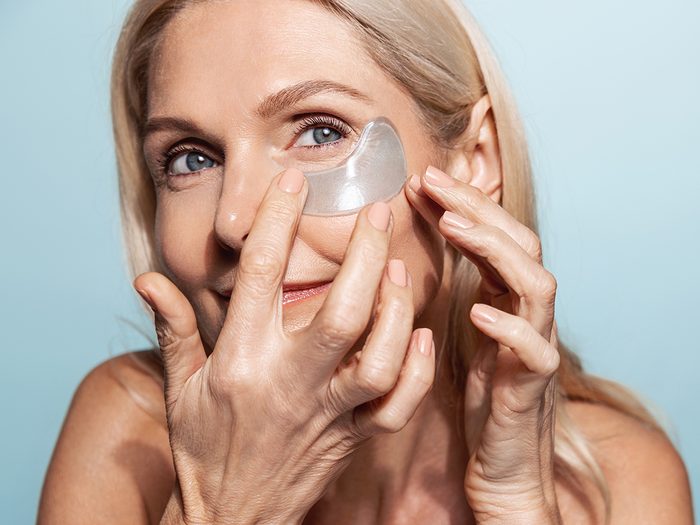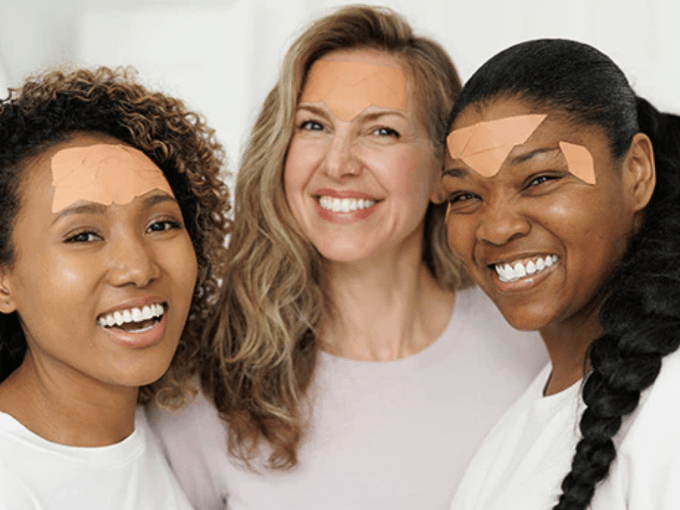Do Wrinkle Patches Actually Work?

We asked dermatology experts to tell us whether wrinkle patches are effective or a gimmicky waste of money.
In the quest for a smooth and eternally youthful, line-free face, many consumers will try it all. Wrinkle stickers and facial patches are a low-cost, non-invasive option that have been around in various iterations since the late 1800s, believe it or not. They’re often marketed with slightly infantilizing or patronizing brand names (case in point: Frownies or Wrinkles Schminkles), claiming to minimize our wrinkles while also, perhaps, minimizing or trivializing our skin-care concerns—the product of an ageist world rife with unrealistic beauty standards.
At $25 to $45 per box, these stickers and facial patches are considerably cheaper than procedures involving needles and injections. It’s a low-risk, at-home DIY approach not unlike wearing a sheet mask: Just stick them on your forehead, cleavage or “elevens” (lines between your eyebrows) while you Netflix at home, or overnight while you sleep. There are reusable silicone patches that contain moisturizers and hydrating ingredients to “reduce wrinkles” and “tighten fine lines,” and there are orangey-peach stickers you cut into geometric shapes yourself and then adhere to your forehead, like puzzle pieces.
(Related: Can the Facial Massages on TikTok Really Change Your Face?)

However, in order for wrinkle stickers to work, you have to wear the patches for at least six hours. And depending on your confidence levels, it could be a little demoralizing to walk around your house, or climb into bed next to your partner, with a face plastered in stickers. Instead of embracing a hard-earned laugh line with pride, you’re almost calling more attention to it. Botoxing your wrinkles away addresses the same signs of aging and lasts much longer, but it costs a lot more. It’s also a fairly quick procedure that happens in the relative privacy of a medical office or cosmetic clinic.
We asked two experts—dermatologist Geeta Yadav, the founder of FACET Dermatology, and Neha Goyal, the co-medical director of MD Beauty Clinic—to explain how wrinkle patches claim to work and whether they’re worth trying.
OK, let’s get this out of the way first: Are wrinkle stickers complete quackery, or legit skincare science?
Yadav: I wouldn’t call it quackery, but I wouldn’t call it particularly scientific, either. These patches simply help to inhibit facial movement that causes wrinkles—nothing more complicated than that, unless they’re silicone.
Goyal: They may work temporarily for some individuals, especially for preventing “sleep lines,” but it’s not a truly effective solution. We also don’t have literature to support the claims.
Are wrinkle stickers kind of an old-fashioned idea, repackaged and marketed as something new and trendy?
Yadav: Yes, it’s a pretty dated idea. Though it’s not as popular now as it was during the Old Hollywood era, a lot of makeup artists would tape a celebrity’s face to help the skin appear more taut. This is similar in concept, just without the pulling-and-lifting aspect. It’s holding skin in place.
Goyal: There was a real explosion in beauty products and trends like this in the late 19th century, but we’ve come a long way since then. They did the best they could with what they had, and it was a smart idea at the time! But now we have the single most effective beauty invention in the history of time at our disposal: Botox. There’s just no comparison.
Are there any risks to these stickers?
Goyal: There’s a real risk of an allergic reaction to the glue or adhesive. A facial tape that I do find intriguing is the “face lift” tapes. For someone without allergies to adhesives, this has the potential to provide a temporary, but effective, lift when hidden under the right hair style for a big event.
Is it just tension from stretching the skin before applying the sticker, or is there an ingredient in the patches, the same way there’s hydrating ingredients in typical sheet masks?
Yadav: It depends on the product. Most paper patches use an adhesive to stay in place and help limit facial movements where they’re placed, which helps to temporarily fade the appearance of wrinkles. Silicone patches work similarly, but also help plump the skin beneath it to smooth the look of wrinkles for a slightly longer period of time than paper patches can.
Goyal: Ingredients like silicone or hyaluronic acid in certain facial tapes can increase hydration in a targeted area which might provide temporarily improvement in wrinkling as well. This benefit is short-lived, but it might be good right before an event. Personally, I would prefer a consistent (and effective) skin care regimen and a face mask to achieve the same effect.
How long do you have to wear wrinkle stickers and facial patches to see results?
Yadav: They’re not treatments that are effective long-term, so you won’t see compounding benefits. To see temporary results, you’ll need to wear them for at least six hours. They can look goofy and can be hard to commit to during the daytime, so many people choose to wear them while they sleep.
Are there certain types of wrinkles that are more easily addressed with a patch, like the “elevens,” versus other kinds of fine lines around your eyes, or forehead wrinkles?
Yadav: I would say forehead and glabella wrinkles are easier to treat with patches. The most challenging types of wrinkles to address are neck and chest wrinkles, as these are not caused by dynamic movements.
Goyal: This will depend on your anatomy, muscle patterning and muscle strength, so the effect will vary for individuals. I would think targeting crow’s feet would be a lot more challenging than the “elevens,” since crow’s feet are the result of years and years of smiling and laughing. It’s hard not to smile when you feel happy—and why would you want to stop yourself from laughing when something is funny? When we target crow’s feet with neuromodulators like Botox or Dysport, we can customize how deeply you’d like to express your smile. But the way these patches work is by tricking you into not smiling or frowning.
Some of these companies make the patches “flesh-toned,” but of course they are not geared at different skin tones (much like most bandages are typically a non-inclusive peachy colour). Do any companies do a better job of reflecting and serving a more diverse range of skin tones?
Goyal: Not that I’ve seen. There’s so much work to be done in the medical aesthetics space when it comes to diversity, representation and inclusion. And it’s more than just a representation problem—many of the technologies that come to market don’t equally address the concerns of all skin types. It has improved in the past few years, but it’s still a real problem.
Yadav: I would just use silicone wrinkle patches—they’re clear.
OK, so tell us about treatments that are more effective than wrinkle patches. How do the results compare?
Yadav: Hands down, Botox and other neurotoxin injections are far more effective than any topical treatment you’d use to combat wrinkles, especially wrinkle patches.
Goyal: The reason why neurotoxin treatment (Botox, Dysport, Xeomin, etc.) works so well is because it inhibits the muscle’s ability to contract for 3 to 4 months—creating a long-lasting effect.
Neurotoxins can sound scary—how do they work?
Yadav: Neurotoxins work by limiting the nerve signals that trigger muscle contractions, reducing your facial movements. Because the treatment lasts for several months rather than the several hours you’d wear a wrinkle patch, the skin is able to smooth out and wrinkles will fade, especially if they are not very deep. The only way wrinkle patches can help you—beyond the period of time in which you use them—is to help you train yourself to limit your facial movements, which is very hard for most people. The less you move your face, the less you’ll wrinkle, but for most people, that’s not a realistic way to live life.
Not everyone feels comfortable with injecting something that sounds like a toxic chemical, though.
Goyal: Neuromodulators are the single greatest beauty invention the world has ever seen. And the way we administer them has really improved in the last 20 years—many patients are surprised that they can soften their “elevens” or “wifi” lines while still maintaining movement and expression. I really avoid creating that “frozen” look for my patients. And if neurotoxin treatment is not your cup of tea, there are other modalities that can improve your skin quality and diminish the look of fine lines and wrinkles: a really solid skincare regime and a mix of in-clinic treatments. We can get a lot done with peels, daily sunscreen use, micro-needling and laser treatments. But I always caution that nothing will be as effective as neurotoxin treatment for fine lines and wrinkles.




